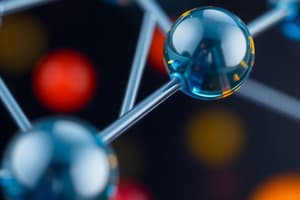Podcast
Questions and Answers
What is the maximum number of electrons the second and third energy levels can hold?
What is the maximum number of electrons the second and third energy levels can hold?
- 8 electrons (correct)
- 6 electrons
- 10 electrons
- 4 electrons
What is formed when an atom loses electrons?
What is formed when an atom loses electrons?
- An anion
- A cation (correct)
- A neutral atom
- A free radical
Which element has only one electron in its outermost shell?
Which element has only one electron in its outermost shell?
- Lithium (correct)
- Fluorine
- Beryllium
- Neon
What is meant by the octet rule?
What is meant by the octet rule?
Why does sodium prefer to lose one electron rather than gain seven?
Why does sodium prefer to lose one electron rather than gain seven?
What charge does a chloride ion have after it gains an electron?
What charge does a chloride ion have after it gains an electron?
What happens when an atom has an unequal number of protons and electrons?
What happens when an atom has an unequal number of protons and electrons?
What happens to the concentration of Carbon-14 in an organism after it dies?
What happens to the concentration of Carbon-14 in an organism after it dies?
Why do chemical bonds form between elements?
Why do chemical bonds form between elements?
Which statement best describes the process of electron transfer?
Which statement best describes the process of electron transfer?
How many elements are found in the first row of the periodic table?
How many elements are found in the first row of the periodic table?
What is the process called when Carbon-14 decays to Nitrogen-14?
What is the process called when Carbon-14 decays to Nitrogen-14?
In the formation of ionic bonds, why do positive and negative ions attract each other?
In the formation of ionic bonds, why do positive and negative ions attract each other?
What is the arrangement of electrons in higher energy levels?
What is the arrangement of electrons in higher energy levels?
How long is the half-life of Carbon-14?
How long is the half-life of Carbon-14?
What defines an ionic bond?
What defines an ionic bond?
What is the maximum age limit for objects that can be dated using Carbon-14?
What is the maximum age limit for objects that can be dated using Carbon-14?
Which ion is formed from sodium after losing an electron?
Which ion is formed from sodium after losing an electron?
Which element completes its outer shell with eight electrons?
Which element completes its outer shell with eight electrons?
Which of the following isotopes is typically used for dating older fossils than those dated by Carbon-14?
Which of the following isotopes is typically used for dating older fossils than those dated by Carbon-14?
How many electrons does a chlorine atom have after gaining one electron?
How many electrons does a chlorine atom have after gaining one electron?
Which shell around the atom's nucleus is filled first with electrons?
Which shell around the atom's nucleus is filled first with electrons?
How many electrons can the closest shell to the nucleus hold?
How many electrons can the closest shell to the nucleus hold?
What determines how elements interact with one another?
What determines how elements interact with one another?
What type of bond forms when an electron is shared between two elements?
What type of bond forms when an electron is shared between two elements?
Which characteristic distinguishes covalent bonds from ionic bonds in the context of water?
Which characteristic distinguishes covalent bonds from ionic bonds in the context of water?
How many shared electrons are needed for two nitrogen atoms to fill their outermost shells?
How many shared electrons are needed for two nitrogen atoms to fill their outermost shells?
What type of covalent bond occurs when electrons are shared equally between atoms?
What type of covalent bond occurs when electrons are shared equally between atoms?
In methane (CH4), how many electrons does the carbon atom share with hydrogen atoms?
In methane (CH4), how many electrons does the carbon atom share with hydrogen atoms?
What is the bond type between two oxygen atoms forming oxygen gas (O2)?
What is the bond type between two oxygen atoms forming oxygen gas (O2)?
What is formed as a result of ionic bonding between sodium and chloride ions?
What is formed as a result of ionic bonding between sodium and chloride ions?
Which statement correctly describes polar covalent bonds?
Which statement correctly describes polar covalent bonds?
What is indicated by the unequal distribution of electrons in a polar covalent bond?
What is indicated by the unequal distribution of electrons in a polar covalent bond?
In a water molecule, which atom carries a slightly negative charge?
In a water molecule, which atom carries a slightly negative charge?
What primarily causes the formation of hydrogen bonds in water?
What primarily causes the formation of hydrogen bonds in water?
Which statement best describes the relationship between polar covalent bonds and the properties of water?
Which statement best describes the relationship between polar covalent bonds and the properties of water?
What type of bonds are weaker compared to ionic and covalent bonds?
What type of bonds are weaker compared to ionic and covalent bonds?
What change would occur to water if hydrogen bonding did not exist?
What change would occur to water if hydrogen bonding did not exist?
Which molecule is an example of a nonpolar bond?
Which molecule is an example of a nonpolar bond?
What does the δ+ symbol represent in polar covalent bonding?
What does the δ+ symbol represent in polar covalent bonding?
What percentage of the human body is primarily composed of water?
What percentage of the human body is primarily composed of water?
What is the main reason that water is critical to life as we know it?
What is the main reason that water is critical to life as we know it?
Which statement best describes why water behaves as a polar molecule?
Which statement best describes why water behaves as a polar molecule?
What term is used to describe substances that do not mix with water?
What term is used to describe substances that do not mix with water?
How do hydrogen bonds in water affect its temperature stability?
How do hydrogen bonds in water affect its temperature stability?
Which description correctly defines water's ability to moderate temperature changes?
Which description correctly defines water's ability to moderate temperature changes?
What phenomenon causes the unique shape of water molecules?
What phenomenon causes the unique shape of water molecules?
Why are substances that easily form hydrogen bonds with water said to be hydrophilic?
Why are substances that easily form hydrogen bonds with water said to be hydrophilic?
Flashcards
Carbon-14
Carbon-14
A naturally occurring radioisotope created in the atmosphere by cosmic rays, used for carbon dating.
Radioisotope
Radioisotope
An unstable isotope of an element that decays over time.
Carbon Dating
Carbon Dating
A method to determine the age of formerly living objects, estimating how long an organism has been dead.
Half-life
Half-life
Signup and view all the flashcards
Beta Decay
Beta Decay
Signup and view all the flashcards
Fossil Age Range (Carbon-14)
Fossil Age Range (Carbon-14)
Signup and view all the flashcards
Isotope
Isotope
Signup and view all the flashcards
Electron Shells
Electron Shells
Signup and view all the flashcards
Electron Shell Capacity
Electron Shell Capacity
Signup and view all the flashcards
Octet Rule
Octet Rule
Signup and view all the flashcards
First Electron Shell
First Electron Shell
Signup and view all the flashcards
Second and Third Electron Shells
Second and Third Electron Shells
Signup and view all the flashcards
Periodic Table Rows
Periodic Table Rows
Signup and view all the flashcards
Chemical Bonds
Chemical Bonds
Signup and view all the flashcards
Ions
Ions
Signup and view all the flashcards
Ionic bond
Ionic bond
Signup and view all the flashcards
Cation
Cation
Signup and view all the flashcards
Electron transfer
Electron transfer
Signup and view all the flashcards
Sodium ion
Sodium ion
Signup and view all the flashcards
Chloride ion
Chloride ion
Signup and view all the flashcards
Ionic Compound
Ionic Compound
Signup and view all the flashcards
Covalent Bond
Covalent Bond
Signup and view all the flashcards
Nonpolar Covalent Bond
Nonpolar Covalent Bond
Signup and view all the flashcards
Polar Covalent Bond
Polar Covalent Bond
Signup and view all the flashcards
What makes a covalent bond strong?
What makes a covalent bond strong?
Signup and view all the flashcards
How many covalent bonds form?
How many covalent bonds form?
Signup and view all the flashcards
Why do atoms form bonds?
Why do atoms form bonds?
Signup and view all the flashcards
Different types of bonds in water
Different types of bonds in water
Signup and view all the flashcards
Water's Polarity
Water's Polarity
Signup and view all the flashcards
Hydrogen Bonding
Hydrogen Bonding
Signup and view all the flashcards
Hydrophilic
Hydrophilic
Signup and view all the flashcards
Hydrophobic
Hydrophobic
Signup and view all the flashcards
Water's Role in Temperature Regulation
Water's Role in Temperature Regulation
Signup and view all the flashcards
How Hydrogen Bonds Affect Heat Absorption
How Hydrogen Bonds Affect Heat Absorption
Signup and view all the flashcards
Water's Importance for Life
Water's Importance for Life
Signup and view all the flashcards
What Makes Water Unique?
What Makes Water Unique?
Signup and view all the flashcards
What makes water polar?
What makes water polar?
Signup and view all the flashcards
Why is hydrogen bonding important?
Why is hydrogen bonding important?
Signup and view all the flashcards
Van der Waals Interactions
Van der Waals Interactions
Signup and view all the flashcards
Compare ionic and covalent bonds
Compare ionic and covalent bonds
Signup and view all the flashcards
Nonpolar bond
Nonpolar bond
Signup and view all the flashcards
Why are weak bonds important?
Why are weak bonds important?
Signup and view all the flashcards
Study Notes
Chapter 2: Chemistry of Life
- Matter occupies space and has mass
- Elements are substances that cannot be broken down chemically
- Each element is made of atoms with a constant number of protons and unique properties
- 118 elements are defined naturally, only 92 occur and fewer than 30 are found in living cells
2.1 The Building Blocks of Molecules
- Atoms are the fundamental unit of an element.
- Atoms are composed of protons (positive charge, mass of 1), neutrons (neutral charge, mass of 1), and electrons (negative charge, negligible mass) located in shells around the nucleus.
Atomic Structure
- Protons and neutrons are in the nucleus
- Electrons are outside the nucleus in electron shells
- Atoms are electrically neutral because the number of protons equals the number of electrons
- Isotopes are different forms of the same element with the same number of protons but a different number of neutrons
Chemical Bonding
- Elements combine to form molecules through chemical bonds.
- Ionic bonds form between oppositely charged ions by electron transfer
- Covalent bonds form when atoms share electrons, creating molecules
- Polar covalent bonds result when electrons are unequally shared, causing a partial positive charge and a negative charge in the molecule
- Nonpolar covalent bonds result when electrons are shared equally between elements
- Hydrogen bonds are weak bonds between a hydrogen atom and an electronegative atom.
- van der Waals interactions are weak interactions between molecules.
Studying That Suits You
Use AI to generate personalized quizzes and flashcards to suit your learning preferences.




